Don Barrow Map Magnifier History

An original 1971 'Grey' Don Barrow Light

An original 1975 'Orange' Don Barrow Light
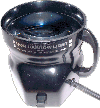
An original 1976 'MK 02' Don Barrow Light

An original 1978 'MK B6' Don Barrow Light
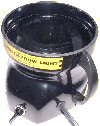
An original 1987 'MK RB7' Don Barrow Light
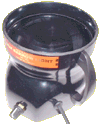
An original 1984 'MK RB8' Don Barrow Light
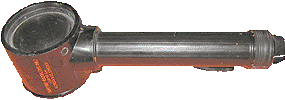
Ex Army & Navy Stores RAF Map Magnifier - 1940s fitted with a Perspex Graticule baseplate with circular radius rings and a cross cursor.
My knowledge of Map Magnifiers goes back to around 1956, when I purchased an ex-RAF hand held Magnifier with a 7.5cm lens. I remember paying about 5/- (Five Shillings) in old money, the equivalent of £00.25p at todays (2006) prices and I bought it from Ron Wilson's (see Autobiography) Emporium, the Army & Navy Stores, Chestergate, Macclesfield. This was a battery powered device with a long handle holding two or three HP2 batteries and in order to survive a night Rally I had to change batteries at the half-way on a 200 mile event. Needless to say I soon cut the handle off, silver soldered a blank cap on and fitted a rheostat, knob and flex and 'Hey Presto' my first Map magnifier.
The magnifier on the Right is one that Ralph Stokes used on many of his forays and Don is sure it dates back to World war 2 and was used by the RAF, the long handle housed a mammoth rheostat for dimming the 4 bulbs installed within.As far as he can remember there was no mention of the word 'Poti', 'Potti', 'Pottie' or 'Pottee', relating to map magnifiers around this period, so can only come to the most obvious conclusion, which I relate to in my next paragraphs.
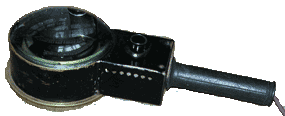
As used by Ralph Stokes Era & manufacturer unknown

You can use this widget to input text into the page.
There were other various devices on the market, an 'Eolite' and 'Allanlight', the Eolite being the most popular. Don eventually purchased his own Eolite in 1959 at a cost of Five Guinea's (Five pounds and Five shillings) in old money, (£5.25p today) (He remembers that his weekly pay packet was only £8.10s.6d in those days! for a 46.5 Hour Week!!). These were well made with a self contained lighting unit using a 6 watt festoon bulb. The lens diameter was 4" (10.2 cm) and they came fitted with a 1" Romer and a Graticule Baseplate which was attached with four 6BA countersunk screws, you can imagine losing one of those screws in the thick carpets of a typical rally car of the era; you had No Chance of ever finding them! These units transformed Rally Navigation because the old style of 1" to the Mile Ordnance Survey maps were extremely difficult to read. Imagine 75% of the Yellow roads on today's maps, being 'White' unknown 'Goers' (the period jargon for a footpath or road that you could drive through, was either a 'Goer' or 'Non Goer') and you just about have a good picture of what the Navigator had to cope with. Naturally the Eolite became the most sought after Map Magnifier of the early 1960's. And having survived many a 'prang' Don's original is on display in the shop today.
Around the same period 1950's - 1960's the more affluent Navigators (or should we say Drivers, because they more than likely bought the equipment?) somehow managed to use an Allenlight (they were about 13" - 33cm in diameter) costing around £8.10s.0d. (£8.50p in todays money).Eventually the production of both the above Map magnifiers died natural deaths.

1950s Allenlight

An original 1960s Pottie
Half way through the 1960's another device came onto the scene and this was actually called a 'Potti', can you imagine producing a Map magnifier and giving it the same name as a baby's loo ! It consisted of a tubular metal pressing 13.5cm tall x 12.0cm diameter with a 7.0cm glass lens affixed to the top. These were made and marketed by a company in London, called 'Motor Books'. Being completely open down one side, the idea being that you could plot with a pencil very easily, but it also let plenty of light OUT and directly shining into the Drivers eyes! Thus defeating the whole exercise. It sold for 49/6d which was £2.9s.6d in old money (£2.47p today).Don only looked at one once, it was like looking at a map by peering down through a glass milk bottle, because being used to an Eolite, which gave you a much clearer vision of the Map and route, automatically increased your expectations. Everyone was desperately searching to purchase an Eolite and Don thought to himself, can he make a Map Magnifier which is either better or equal to the Eolite! He tried and tried during the years 1969 - 1971 and eventually managed to make all the moulds, punches, dies and tooling etc, to enable him to produce his very own Don Barrow Light. These are still produced and moulded into shape on the very same original dies that Don made 50 years ago. The original DB Lights were grey in colour, then changed to orange and finally the current black versions. You can usually gauge the seriousness of a Navigator by the type of Map Magnifier they are using. Various other types have come and gone, some were even made out of White PVC - W.C. Toilet Outlet Connectors with Acrylic lenses and were called Terrain Followers.We are sure we do not have to remind you the high cost of crystal glass lenses today, someone you know will have purchased a pair of glasses and will have remarked about the price! but it is the only way to produce a high quality and clarity lens that doesn't scratch easily.
Around the late 1970s Dave Ottridge produced his Terrain Follower magnifier, acrylic lens and WC connector body, the WC connectors were produced by a company called Terrain Plastics and Dave cleverly used their name Terrain as part of his magnifier title, the early ones had about 3" or 75mm diameter lenses and were a bit like the metal Poti above in that it was like looking down a milk bottle.Later on he used a 4" or 110mm acrylic lens and another WC connector from the same Terrain Plastics catalogue, it was quite good but prone to scratching of the lens and a bit bulky in size.
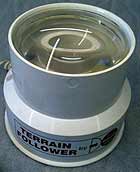
1980s Terrain Follower MK2
The original lights above can be seen at our showroom in Tarvin - Call before visiting to check we are open
